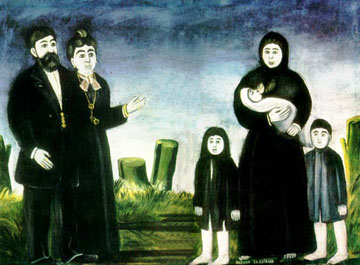|

aving a father who was a film director involved the wonderful fact, that seeing and talking about Cinema was one of the essential and everyday things of life.
For years the whole family would separately go to see one or more films a day and then discuss them during dinner.
My father, who had to realize very early in his career, that his vision of European Cinema was not to be put into reality in the Greece of the
50s and 60s, made only 14 films and then founded an Art Cinema, bringing non-commercial films to Greece at a time most Greeks didn't even imagine cinema like that could exist elsewhere.
He was the first one to show films by Andrei Tarkovsky, Akira Kurosawa, Kenji Mizoguchi, Rainer Werner Fassbinder, Jean-Luc
Godard and Marta Meszaros, he screened Pier Pasolini's "Salo" and Emir Kusturica's first film "Do You Remember Dolly Bell?"
I actually wanted to become a film director, but was not brave enough to risk a career under the shadow of his name at that time, it took me
years to publish my first book of poetry (him being an acknowledged writer and poet as well), and after years of working as a German teacher and translator of literature, I came close to my dream by
ending up in theatre.
My love for Cinema is still as strong as it used to be, a life long passion, and I keep updating our private film collection with new releases of Classical films on video and DVD.
This year a film will be released that is among my all-time favourite films: "Pirosmani", made in 1969 by the Georgian Director Georgy
Shengelaya. It won awards from the British Film Institute and the Chicago Film Festival.
The film is about the life and the work of Nikola Pirosmanishvili (1863-1918), known as Niko Pirosmani,  a Georgian painter whose work came to be recognised several years after his death. a Georgian painter whose work came to be recognised several years after his death.
Pirosmani died of starvation, unable to sell any of his works for sufficient money to support life. Ironically, his primitivist style was later very much in fashion, and huge
sums were paid for his surviving paintings. This well-regarded film focuses on Pirosmani's everyday life in the Georgia of his time, and is photographed in a bold style, which echoes the artist's vision and
causes the viewer to enter into it. This is necessary, because little factual material about the artist was available; most of his biography was composed of legends and recorded gossip.
The film's director, Georgy Shengelaya, is the son of  Nikolai
Shengelaya, one of the founders of Georgia's film industry. His mother was an early Georgian movie star. Shengelaya made the film out of pure nostalgia having reconstructed the taverns and palaces of
Tiflis from photographs and pictures of that period. He follows the painter's life through the richness of the paintings and the simple beauty of old stones
and buildings in the city. The film is a rare case in its success to incorporate the work of an artist into his life experience, identifying ultimately these two ostensibly opposed
elements. Pirosmani's own anxieties - his alcoholism and his suppressed desire for a singer - are implicitly stated through his work rather than directly being pointed at. The main virtue of the film,
namely its atmosphere and visual splendour, are largely due to Konstantin Apryatin's marvellous photography. The perfectly symmetrical shots of Pirosmani's life and work possess all the
formalism, which is required to portray life through art, while his naturalistic paintings reveal a variety of richly earthly colours. Nikolai
Shengelaya, one of the founders of Georgia's film industry. His mother was an early Georgian movie star. Shengelaya made the film out of pure nostalgia having reconstructed the taverns and palaces of
Tiflis from photographs and pictures of that period. He follows the painter's life through the richness of the paintings and the simple beauty of old stones
and buildings in the city. The film is a rare case in its success to incorporate the work of an artist into his life experience, identifying ultimately these two ostensibly opposed
elements. Pirosmani's own anxieties - his alcoholism and his suppressed desire for a singer - are implicitly stated through his work rather than directly being pointed at. The main virtue of the film,
namely its atmosphere and visual splendour, are largely due to Konstantin Apryatin's marvellous photography. The perfectly symmetrical shots of Pirosmani's life and work possess all the
formalism, which is required to portray life through art, while his naturalistic paintings reveal a variety of richly earthly colours.
 |
There are moments of Surrealist explosions such as the one with the artist daydreaming about encountering a black shepherd with a black
sheep and a white one, a weird scene enhanced by some strangely beautiful folk music.
The dialogue in the film is very restrained, but its poeticism, unmatched aesthetics and insight into Pirosmani's mysterious life
make it less of a film, rather a fascinating wandering inside an art gallery.
In a way we can hardly explain why we love a piece of music, I can't explain why I adore it so much.
Maybe it is simply its magic and beauty, a film where you fall into and submerge under the screen into a different sphere of existence.
Moving a lot during the last years, one of the things I take always with me, among books, records and a rather obscure collection of old,
nostalgic tin cans, is the original poster of the film, that hangs on the wall of my bedroom wherever I am.
The poster symbolises more than just a film or the personal story of a painter, who died penniless in a basement after he couldn't afford any
longer to live near Malakan Bazaar under the stairs room, while his pictures were sold without him every seeing a single ruble.
To me it has to do with the vision of being an artist, the vision of following one's dream, no matter how difficult, imbued with light, joy and love for life.
|